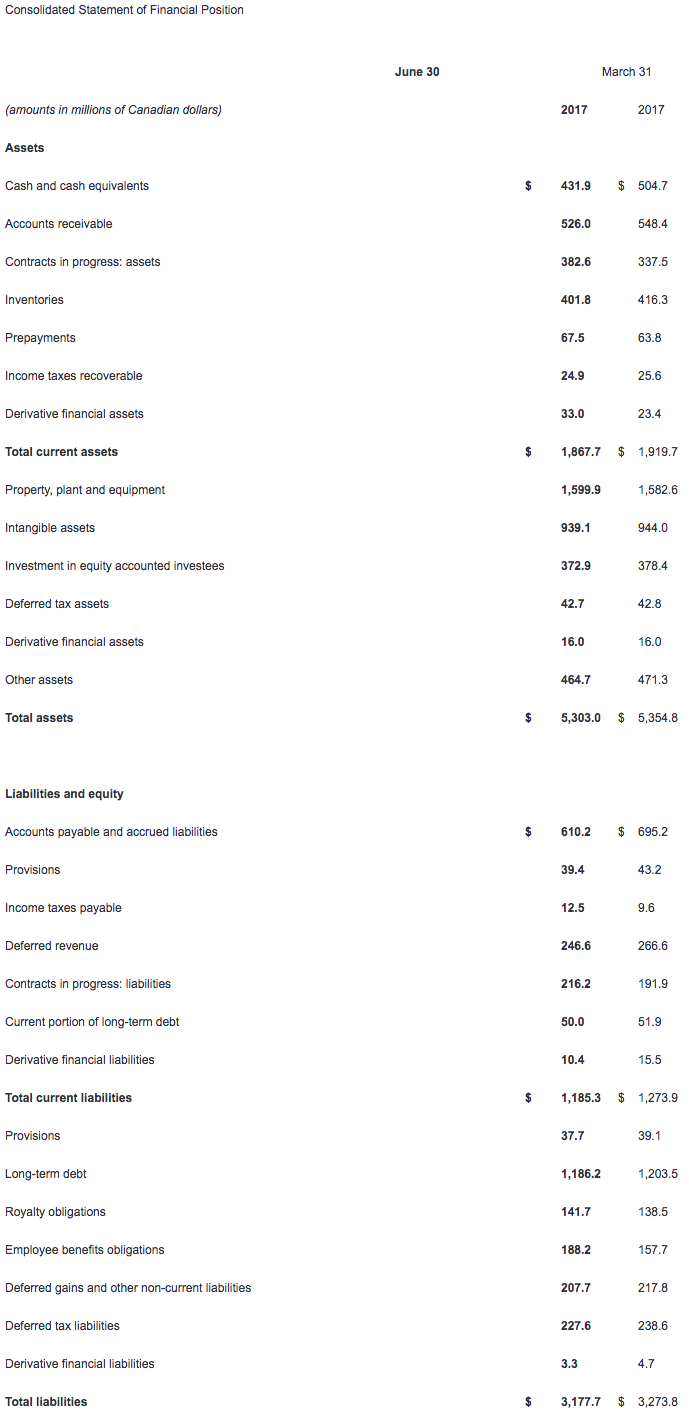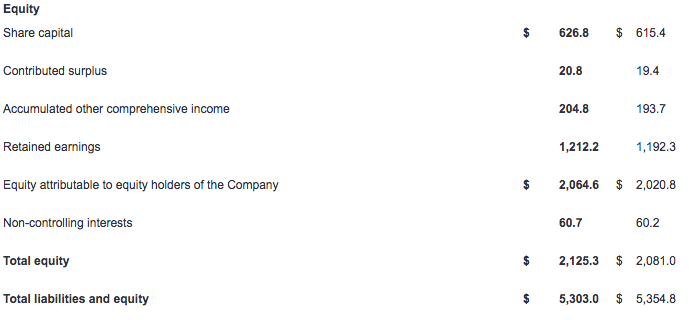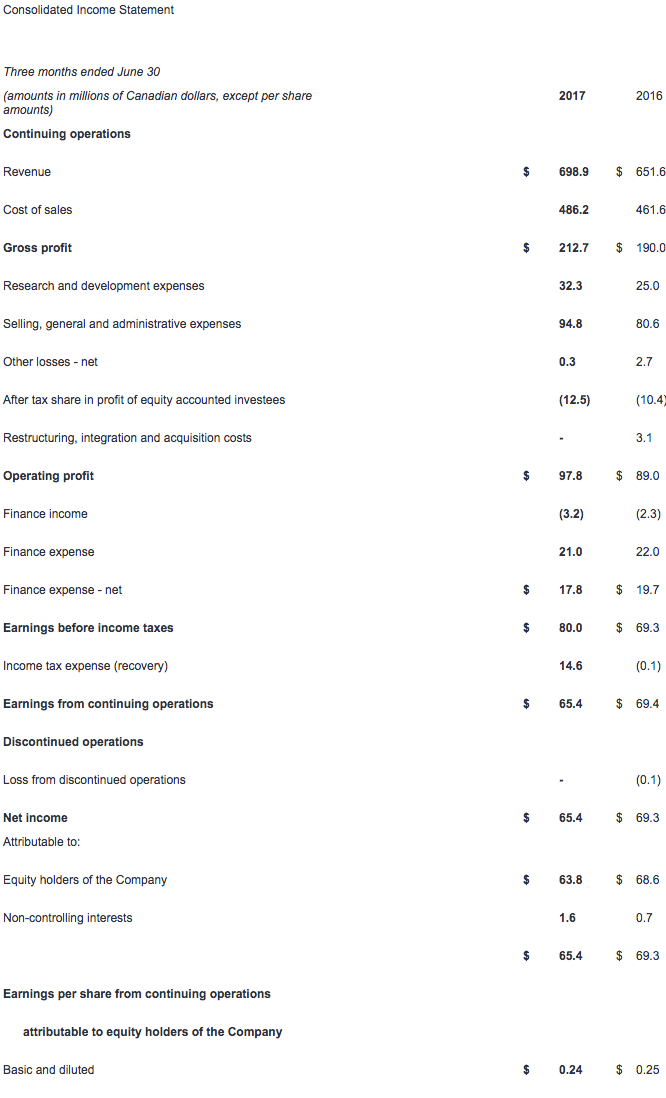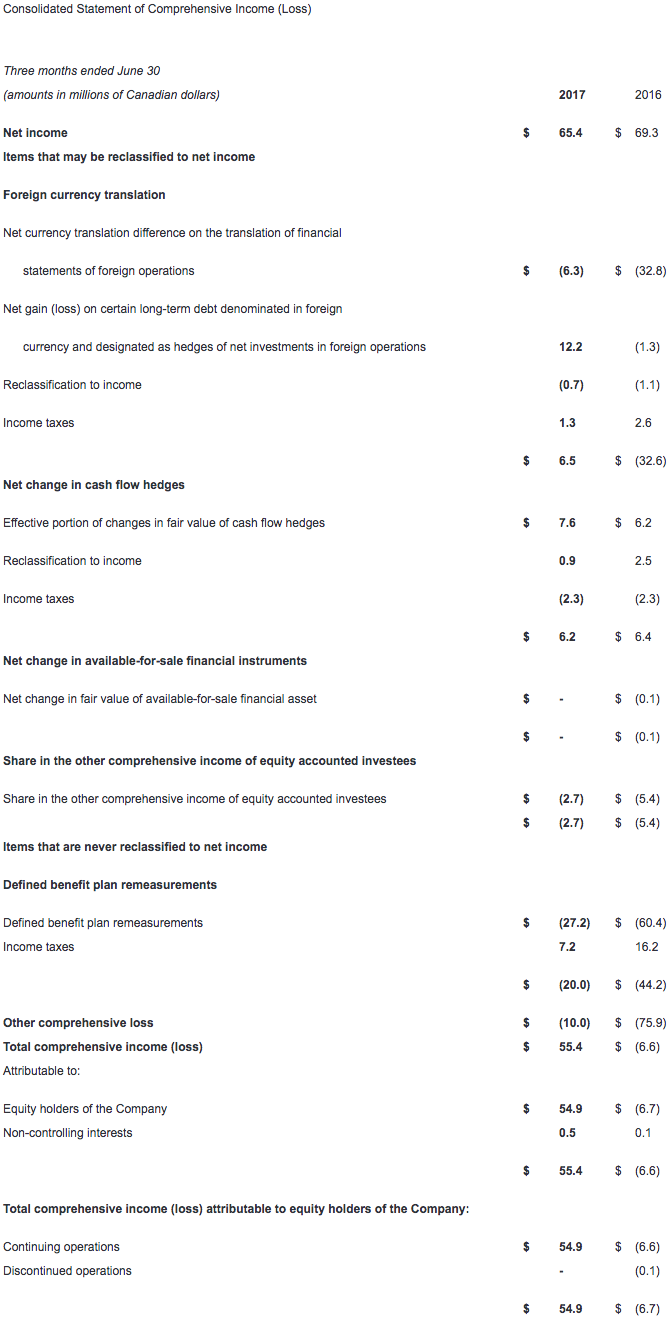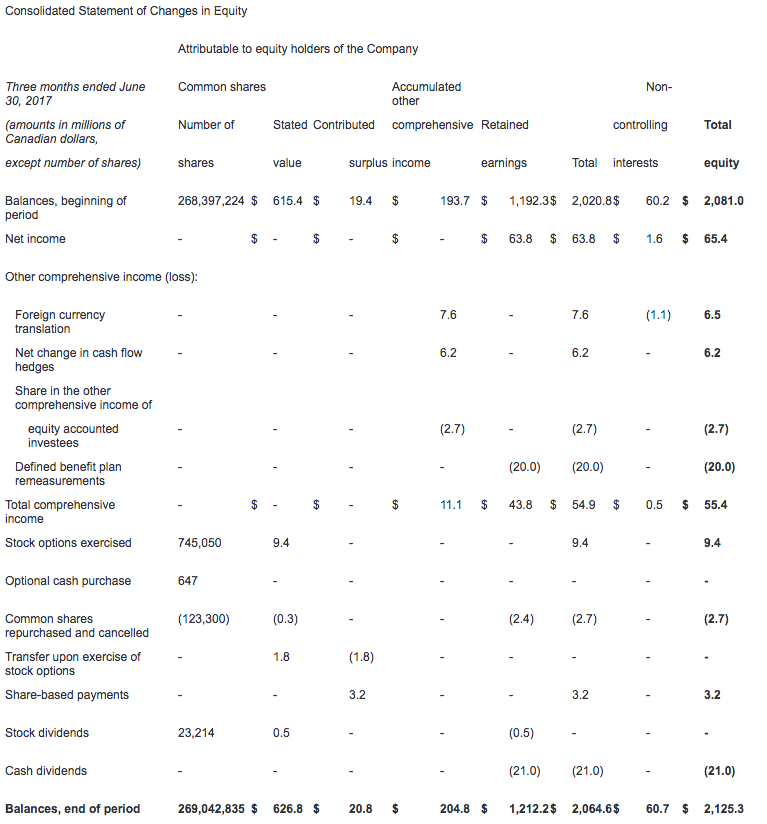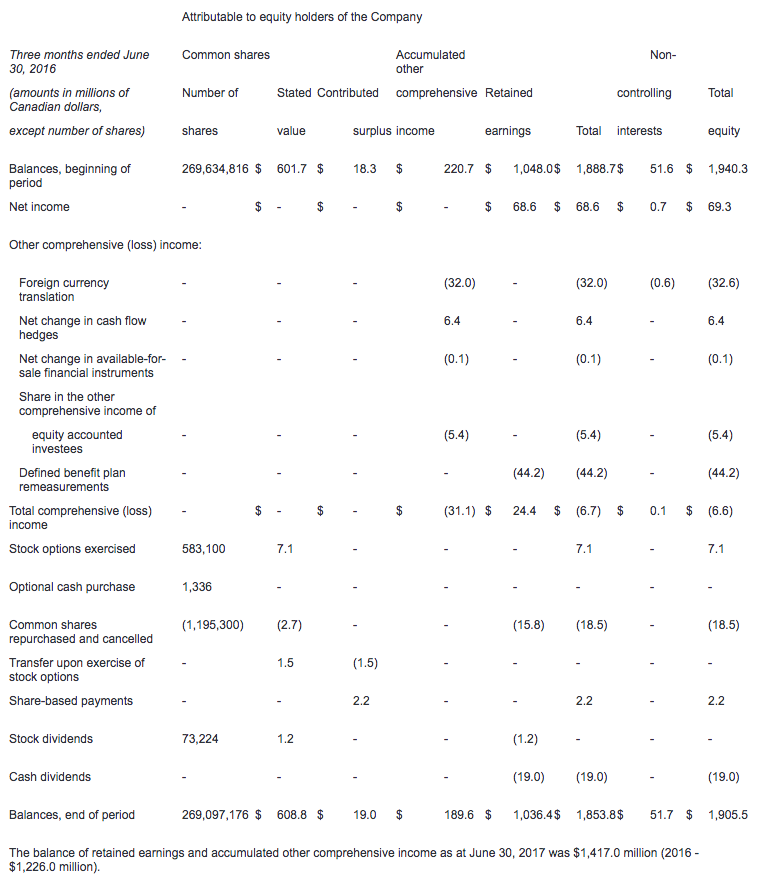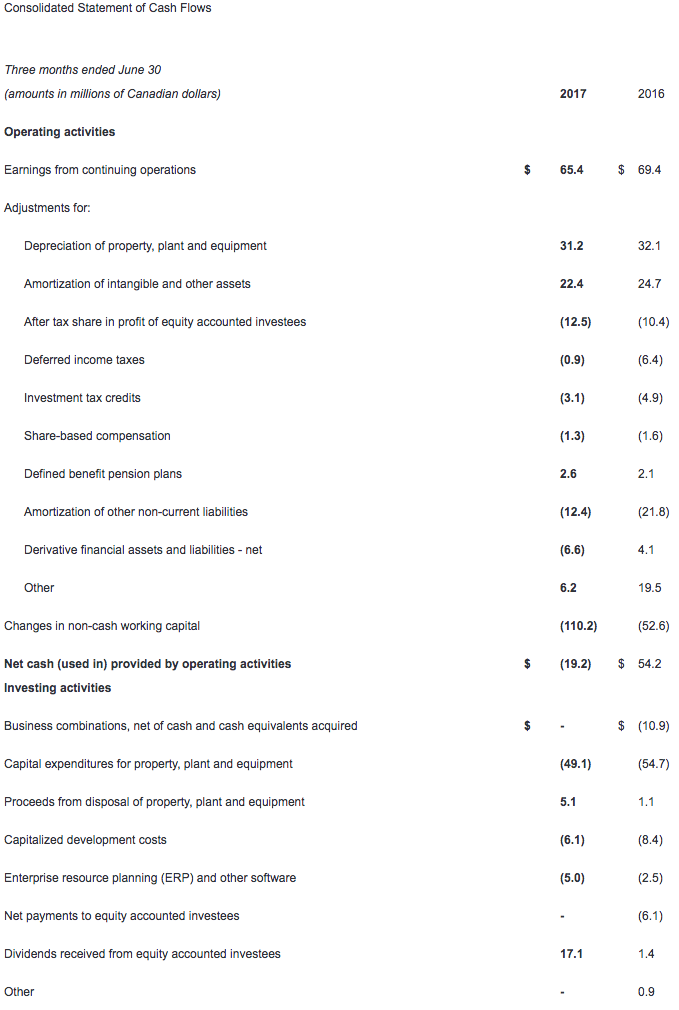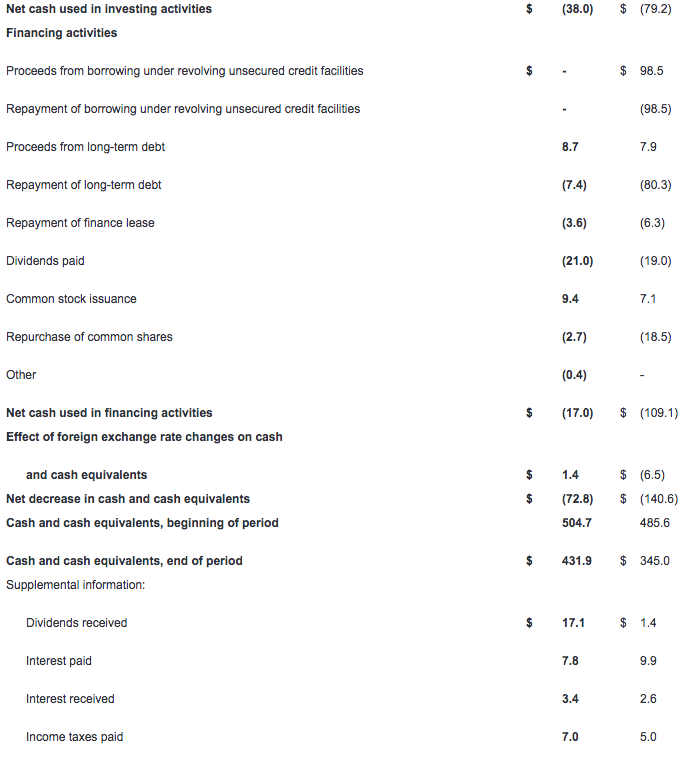

CAE today reported revenue of $698.9 million for the first quarter of fiscal year 2018, compared with $651.6 million in the first quarter last year. First quarter net income attributable to equity holders from continuing operations was $63.8 million ($0.24 per share) compared to $68.7 million ($0.25 per share) last year, or $70.9 million ($0.26 per share) before specific items(2) last year.
First quarter operating profit was $97.8 million (14.0% of revenue) compared with $89.0 million (13.7% of revenue) in the first quarter last year. All financial information is in Canadian dollars unless otherwise indicated.
"Our progress in the first quarter supports our full year outlook, which remains unchanged," said Marc Parent, CAE's President and Chief Executive Officer. "We continue to enjoy good demand for CAE's solutions in a strong market environment. The new strategic developments with airlines announced today strengthen CAE's position in China and the ASEAN region, the fastest growing commercial aviation markets in the world. Underscoring our positive outlook, I am pleased to announce that CAE's Board of Directors has approved a one cent or 13% increase to CAE's quarterly dividend, which becomes nine cents per share, effective September 29, 2017."
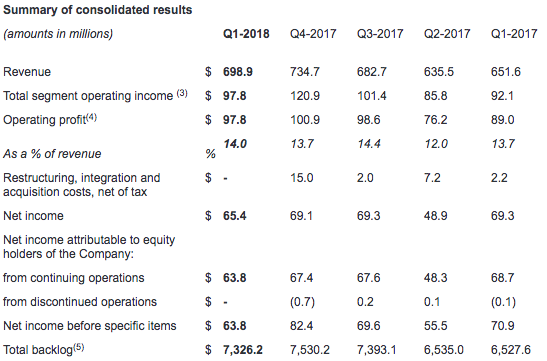
Civil Aviation TrainingSolutions (Civil)
First quarter Civil revenue was $411.8 million, up 11% compared to the same quarter last year, and segment operating income was $73.1 million (17.8% of revenue), up 15% compared to the first quarter last year. First quarter Civil training centre utilization(6) was 78%. The first quarter includes the impact of the standardization of certain types of simulators on revenue recognition. Civil revenue and segment operating income, if adjusted (7)(8) for the impact of this change would have been $452.0 million and $83.7 million this quarter, respectively. The impact during the first quarter of fiscal year 2017 was minimal.
During the quarter, Civil signed training solutions contracts with an order intake(5) value of $400.4 million, including agreements for ab initio pilot training for Jet Airways in India, and business aviation pilot training for MHS Aviation and Elit'Avia in Europe. Also during the quarter, Civil sold 8 full-flight simulators.
The Civil book-to-sales(5) ratio was 0.97x for the quarter and 1.07x for the last 12 months. The Civil backlog at the end of the quarter was $3.2 billion.
Since the end of the quarter, Civil made further progress on CAE's vision to be the worldwide training partner of choice with new strategic developments involving airline customers in Asia.
CAE and Singapore Airlines have signed a Memorandum of Understanding to establish a joint venture (JV) to operate out of the Singapore Airlines Training Centre, near Changi Airport in Singapore. This agreement marks an important evolution in CAE's relationship with one of the world's premiere carriers and its subsidiaries. Once established, the JV will serve the training needs for Singapore Airlines, its subsidiaries, and other Boeing aircraft operators in the ASEAN region. The closing of the transaction is subject to execution of definitive transaction documents and customary closing conditions, including regulatory approvals.
In an agreement between CAE and China Southern Airlines, China Southern has acquired CAE's 49% equity stake in the Zhuhai Flight Training Centre (ZFTC) for US$96 million. The evolution of this relationship allows CAE greater flexibility to address the broader aviation training market in China and the ASEAN region, and the opportunity to align its capital investment with its strategic priorities. As part of the transaction, China Southern Airlines will outsource to CAE third-party airline training being conducted at ZFTC. CAE will continue to serve China Southern as its partner for training services support, ab initio pilot training, and for its simulation equipment needs.
In response to reports published by the media, CAE confirms it is in advanced discussions with AirAsia to conclude a sale and purchase agreement for CAE to acquire AirAsia's 50% share of the Asian Aviation Centre of Excellence Sdn. Bhd. JV. CAE's relationship with AirAsia began in 2004 and with this agreement, it would expand with a contract for all AirAsia training requirements and that of its affiliates, in support of all the aircraft types it operates for an extended term. The transaction is subject to the successful conclusion of a sale and purchase agreement between the parties.
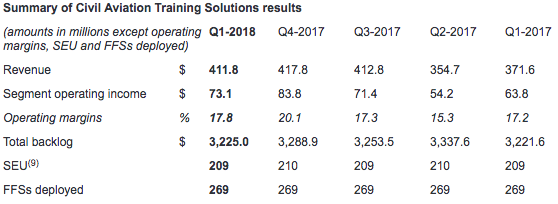
Defence and Security (Defence)
First quarter Defence revenue was $263.2 million, up 2% compared to the same quarter last year and segment operating income was $26.3 million (10.0% of revenue), compared to $28.4 million (11.0% of revenue) in the first quarter last year.
During the quarter, Defence order intake was valued at $262.4 million. Notable wins include a Training Systems Integration contract with the UAE for a comprehensive training solution for the Predator XP and a contract from Airbus related to the in-service support of the C295W Fixed-Wing Search and Rescue training program in Canada. As well, Defence received a series of orders from Lockheed Martin involving C-130J fuselage trainers for the U.S. Air Force and U.S. Marine Corps. Also notable during the quarter, the first cohort of U.S. Army students to go through the new Initial Entry Fixed-Wing course at CAE's Dothan, Alabama training centre graduated to become Army fixed-wing aviators.
The Defence book-to-sales ratio was 1.00x for the quarter and 1.31x for the last 12 months (excluding contract options). The Defence backlog, including options and CAE's interest in joint ventures, at the end of the quarter was $4.1 billion.

Healthcare
First quarter Healthcare revenue was $23.9 million compared to $22.7 million in the same quarter last year, and first quarter segment operating loss was $1.6 million compared to $0.1 million in the first quarter last year.
CAE Healthcare launched CAE Juno during the first quarter, with first deliveries expected during its second quarter. It is the first contemporary clinical skills manikin that meets requirements for fundamental nurse training - the largest segment of the healthcare education market. CAE Juno complements Healthcare's broad range of high-fidelity simulation solutions and innovations and meets an important need for affordable and modular solutions for nursing. Also during the quarter, Healthcare's, Anesthesia SimSTAT, a screen-based simulation training platform, was approved by the American Board of Anesthesiology for Maintenance of Certification in Anesthesiology credits.

Additional financial highlights
Free cash flow(10) from continuing operations was negative $37.9 million for the quarter compared to positive $15.5 million in the first quarter last year. The decrease in free cash flow results mainly from a higher investment in non-cash working capital and a decrease in cash provided by continuing operating activities, partially offset by higher dividends received from equity accounted investees. CAE usually sees a higher level of investment in non-cash working capital accounts during the first half of the fiscal year and tends to see a portion of these investments reverse in the second half.
Income taxes this quarter were $14.6 million, representing an effective tax rate of 18%, compared to nil for the first quarter last year. The tax rate in the first quarter of last year was impacted by the recognition of a deferred tax item, before which, the tax rate would have been 14%. This item had an approximate $0.04 impact on first quarter EPS last year.
Growth and maintenance capital expenditures(11) totaled $49.1 million this quarter.
Net debt(12) at the end of the quarter was $804.3 million for a net debt-to-total capital ratio(13) of 27.5%. This compares to net debt of $750.7 million and a net debt-to-total capital ratio of 26.5% at the end of the preceding quarter.
Return on capital employed(14) was 10.7% compared to 11.5% last year.
CAE will pay a dividend of nine cents per share effective September 29, 2017 to shareholders of record at the close of business on September 15, 2017.
During the three months ended June 30, 2017, CAE repurchased and cancelled a total of 123,300 common shares under the Normal Course Issuer Bid (NCIB), at a weighted average price of $21.93 per common share, for a total consideration of $2.7 million.
Management outlook for fiscal 2018 unchanged
CAE expects continued good growth in fiscal year 2018. In Civil, the Company expects to generate low-double digit percentage segment operating income growth as it makes more progress to penetrate the training market with its innovative solutions and maintains its leadership position in FFS sales. In Defence, the Company expects mid to high single-digit percentage growth as it begins to ramp up recently won programs from a record backlog and continues to win its fair share of opportunities in a stronger defence market. CAE expects Healthcare to resume growth this year, with increased sales coming from its opportunities pipeline and the launch of new products, which it expects to put it on course for long-term, double-digit growth. The Company expects lower capital intensity in fiscal 2018, with total capital expenditures expected to be in the range of $150 million (vs. $222.9 million in fiscal 2017), commensurate with market-led opportunities for accretive investment returns. Management's expectations are based on the prevailing positive market conditions and customer receptivity to CAE's training solutions as well as material assumptions contained in this press release, quarterly MD&A and in CAE's fiscal year 2017 MD&A.
Impact of the standardization of certain types of simulators on revenue recognition
CAE's process improvement program results in the standardization of certain types of commercial aircraft simulators. For standardized simulators, percentage-of-completion (POC) accounting is no longer appropriate and thus the Company began recognizing revenue upon completion for such simulators in fiscal 2017. To the extent that this impacts the reported performance and to facilitate comparability over the execution cycle period, management has provided the impact of this change on Civil revenue (Civil revenue - adjusted(7)) and Civil segment operating income (Civil segment operating income - adjusted(8)). These are non-GAAP measures.
Detailed information
Readers are strongly advised to view a more detailed discussion of our results by segment in the Management's Discussion and Analysis (MD&A) and CAE's consolidated interim financial statements which are posted on our website at www.cae.com/investors.
CAE's consolidated interim financial statements and MD&A for the quarter ended June 30, 2017 have been filed with the Canadian Securities Administrators on SEDAR (www.sedar.com) and are available on our website (www.cae.com). They have also been filed with the U.S. Securities and Exchange Commission and are available on their website (www.sec.gov). Holders of CAE's securities may also request a hard copy of the Company's consolidated financial statements and MD&A free of charge by contacting the Investor Relations Department ([email protected]).
Conference call Q1 FY2018
CAE President and CEO, Marc Parent; Sonya Branco, Vice President, Finance, and CFO; and Andrew Arnovitz, Vice President, Strategy and Investor Relations will conduct an earnings conference call today at 1:30 p.m. ET. The call is intended for analysts, institutional investors and the media. Participants can listen to the conference by dialling + 1 877 586 3392 or +1 416 981 9024. The conference call will also be audio webcast live for the public at www.cae.com.
CAE is a global leader in training for the civil aviation, defence and security, and healthcare markets. Backed by a 70-year record of industry firsts, we continue to help define global training standards with our innovative virtual-to-live training solutions to make flying safer, maintain defence force readiness and enhance patient safety. We have the broadest global presence in the industry, with over 8,500 employees, 160 sites and training locations in over 35 countries. Each year, we train more than 120,000 civil and defence crewmembers and thousands of healthcare professionals worldwide.
Caution concerning limitations of summary earnings press release
This summary earnings press release contains limited information meant to assist the reader in assessing CAE's performance but it is not a suitable source of information for readers who are unfamiliar with CAE and is not in any way a substitute for the Company's financial statements, notes to the financial statements, and MD&A reports.
Caution concerning forward-looking statements
Certain statements made in this press release are forward-looking statements. These statements include, without limitation, statements relating to our fiscal 2018 financial guidance (including revenues, capital investment and margins) and other statements that are not historical facts. There is no assurance that the transactions with Singapore Airlines and AirAsia contemplated in this press release will be completed at all, or completed upon the same terms and conditions described. Forward-looking statements are typically identified by future or conditional verbs such as anticipate, believe, expect, and may. All such forward-looking statements are made pursuant to the 'safe harbour' provisions of applicable Canadian securities laws and of the United States Private Securities Litigation Reform Act of 1995. Forward-looking statements, by their very nature, are subject to inherent risks and uncertainties and are based on several assumptions, both general and specific, which give rise to the possibility that actual results or events could differ materially from our expectations expressed in or implied by such forward-looking statements and that our business outlook, objectives, plans and strategic priorities may not be achieved. As a result, we cannot guarantee that any forward-looking statement will materialize and we caution you against relying on any of these forward-looking statements. The forward-looking statements contained in this press release describe our expectations as of August 10, 2017 and, accordingly, are subject to change after such date. Except as may be required by Canadian securities laws, we do not undertake any obligation to update or revise any forward-looking statements contained in this news release, whether as a result of new information, future events or otherwise. Except as otherwise indicated by CAE, forward-looking statements do not reflect the potential impact of any special items or of any dispositions, monetizations, mergers, acquisitions, other business combinations or other transactions that may occur after August 10, 2017. The financial impact of these transactions and special items can be complex and depends on the facts particular to each of them. We therefore cannot describe the expected impact in a meaningful way or in the same way we present known risks affecting our business. Forward-looking statements are presented in this press release for the purpose of assisting investors and others in understanding certain key elements of our expected fiscal 2018 financial results and in obtaining a better understanding of our anticipated operating environment. Readers are cautioned that such information may not be appropriate for other purposes. The value of capital investments expected to be made by CAE in FY2018 assumes that capital investments will be made in accordance with our current annual plan. However, there can be no assurance that such investment levels will be maintained with the result that the value of actual capital investments made by CAE during such period could materially differ from current expectations.
Material assumptions
A number of economic, market, operational and financial assumptions were made by CAE in preparing its forward-looking statements for fiscal 2018 contained in this news release, including, but not limited to certain economic and market assumptions including: modest economic growth and interest rates to remain largely unchanged in fiscal 2018; a sustained level of competition in civil, defence & healthcare markets; no material financial, operational or competitive consequences of changes in regulations affecting our business; and a more positive defence market.
Assumptions concerning our businesses
A number of assumptions concerning CAE's business were also made in the preparation of its forward-looking statements for fiscal 2018 contained in this news release, including, but not limited to factors including: productivity and efficiency gains to lower CAE's manufacturing costs and cycle times; maintenance of CAE's market share in civil simulator sales in the face of price competition; and higher Civil training network utilization.
The foregoing assumptions, although considered reasonable by CAE on August 10, 2017, may prove to be inaccurate. Accordingly, our actual results could differ materially from our expectations as set forth in this news release.
Material risks
Important risk factors that could cause our assumptions and estimates to be inaccurate and actual results or events to differ materially from those expressed in or implied by our forward-looking statements, including our fiscal 2018 financial guidance, are set out in CAE's MD&A for the year ended March 31, 2017 filed by CAE with the Canadian Securities Administrators (available at www.sedar.com) and with the U.S. Securities and Exchange Commission (available at www.sec.gov). The fiscal year 2017 MD&A is also available at www.cae.com. The realization of our forward-looking statements, including our ability to meet our fiscal 2018 outlook, essentially depends on our business performance which, in turn, is subject to many risks. Accordingly, readers are cautioned that any of the disclosed risks could have a material adverse effect on our forward-looking statements. We caution that the disclosed list of risk factors is not exhaustive and other factors could also adversely affect our results.
Non-GAAP and other financial measures
This press release includes non-GAAP and other financial measures. Non-GAAP measures are useful supplemental information but may not have a standardized meaning according to GAAP. These measures should not be confused with, or used as an alternative for, performance measures calculated according to GAAP. They should also not be used to compare with similar measures from other companies. Management believes that providing certain non-GAAP measures provides users with a better understanding of our results and trends and provides additional information on our financial and operating performance.
(1) Earnings per share before specific items is a non-GAAP measure calculated by excluding the effect of restructuring, integration and acquisition costs and one-time tax items from the diluted earnings per share from continuing operations attributable to equity holders of the Company. The effect per share is obtained by dividing the restructuring, integration and acquisition costs, net of tax, and one-time tax items by the average number of diluted shares. We track it because we believe it provides a better indication of our operating performance on a per share basis and makes it easier to compare across reporting periods.
(2) Net income before specific items is a non-GAAP measure we use as an alternate view of our operating results. We calculate it by taking our net income attributable to equity holders of the Company from continuing operations and adding back restructuring, integration and acquisition costs, net of tax, and one-time tax items. We track it because we believe it provides a better indication of our operating performance and makes it easier to compare across reporting periods.
(3) Total segment operating income is a non-GAAP measure and is the sum of our key indicator of each segment's financial performance. Segment operating income gives us an indication of the profitability of each segment because it does not include the impact of any items not specifically related to the segment's performance. We calculate total segment operating income by taking the operating profit and excluding the impact of restructuring, integration and acquisition costs.
(4) Operating profit is an additional GAAP measure that shows us how we have performed before the effects of certain financing decisions, tax structures and discontinued operations. We track it because we believe it makes it easier to compare our performance with previous periods, and with companies and industries that do not have the same capital structure or tax laws.
(5) Order Intake and Backlog
Order intake is a non-GAAP measure that represents the expected value of orders we have received:
- For the Civil Aviation Training Solutions segment, we consider an item part of our order intake when we have a legally binding commercial agreement with a client that includes enough detail about each party's obligations to form the basis for a contract and includes the value of expected future revenues. Expected future revenues from customers under short-term and long-term training contracts are included when these customers commit to pay us training fees, or when we reasonably expect the revenue to be generated;
- For the Defence and Security segment, we consider an item part of our order intake when we have a legally binding commercial agreement with a client that includes enough detail about each party's obligations to form the basis for a contract. Defence and Security contracts are usually executed over a long-term period but some of them must be renewed each year. For this segment, we only include a contract item in order intake when the customer has authorized the contract item and has received funding for it;
- For the Healthcare segment, order intake is typically converted into revenue within one year, therefore we assume that order intake is equal to revenue.
The book-to-sales ratio is the total orders divided by total revenue in a given period.
Obligated backlog is a non-GAAP measure that represents the value of our order intake not yet executed and is calculated by adding the order intake of the current period to the balance of the obligated backlog at the end of the previous fiscal year, subtracting the revenue recognized in the current period and adding or subcontracting backlog adjustments. If the amount of an order already recognized in a previous fiscal year is modified, the backlog is revised through adjustments.
Joint venture backlog is obligated backlog that represents the expected value of our share of orders that our joint ventures have received but have not yet executed. Joint venture backlog is determined on the same basis as obligated backlog described above.
Unfunded backlog is a non-GAAP measure that represents firm Defence and Security orders we have received but have not yet executed and for which funding authorization has not yet been obtained. We include unexercised negotiated options which we view as having a high probability of being exercised, but exclude indefinite-delivery/indefinite-quantity (IDIQ) contracts. When an option is exercised, it is removed from the unfunded backlog and is considered order intake in the period that it is exercised.
Total backlog includes obligated backlog, joint venture backlog and unfunded backlog.
(6) Utilization rate is an operating measure we use to assess the performance of our Civil simulator training network. We calculate it by taking the number of training hours sold on our simulators during the period divided by the practical training capacity available for the same period.
(7) Civil revenue - adjusted is a non-GAAP measure we present that takes into account the impact of the change in revenue recognition arising from the standardization of certain types of simulators. We calculate this by taking our Civil revenue and adjusting for the impact of the recognition of revenue upon completion for these simulators versus the revenue that would have otherwise been recognized under POC accounting.
(8) Civil segment operating income - adjusted is a non-GAAP measure we present that takes into account the impact of the change in revenue recognition arising from the standardization of certain types of simulators. We calculate this by taking our Civil segment operating income and adjusting for the impact of the recognition of segment operating income upon completion for these simulators versus the segment operating income that would have otherwise been recognized under POC accounting.
(9) Simulator equivalent unit (SEU) is an operating measure we use to show the total average number of FFSs available to generate earnings during the period.
(10) Free cash flow is a non-GAAP measure that shows us how much cash we have available to invest in growth opportunities, repay debt and meet ongoing financial obligations. We use it as an indicator of our financial strength and liquidity. We calculate it by taking the net cash generated by our continuing operating activities, subtracting maintenance capital expenditures, investment in other assets not related to growth and dividends paid and adding proceeds from the disposal of property, plant and equipment, dividends received from equity accounted investees and proceeds, net of payments, from equity accounted investees.
(11) Maintenance capital expenditure is a non-GAAP measure we use to calculate the investment needed to sustain the current level of economic activity. Growth capital expenditure is a non-GAAP measure we use to calculate the investment needed to increase the current level of economic activity.
(12) Net debt is a non-GAAP measure we use to monitor how much debt we have after taking into account liquid assets such as cash and cash equivalents. We use it as an indicator of our overall financial position, and calculate it by taking our total long-term debt, including the current portion of long-term debt, and subtracting cash and cash equivalents.
(13) Net debt-to-capital is calculated as net debt divided by the sum of total equity plus net debt.
(14) Return on capital employed (ROCE) is a non-GAAP measure we use to evaluate the profitability of our invested capital. We calculate this ratio over a rolling four-quarter period by taking net income attributable to equity holders of the Company excluding net finance expense, after tax, divided by the average capital employed.
For a detailed reconciliation of these measures as well as other non-GAAP and other financial measures monitored by CAE, please refer to CAE's MD&A filed with the Canadian Securities Administrators available on our website (www.cae.com) and on SEDAR (www.sedar.com).
